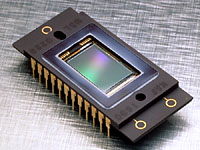 |
New Product Announcement
ST-7E and ST-8E Enhanced CCD Cameras
February 1, 1999
(Update July 14, 1999)
(Revised May 10, 2004)
May 10, 2004: If you reached this page through a search, please note that the ST-7E and ST-8E cameras have undergone several improvements since the original date of this announcement. Both models now include high speed USB for much faster download times, a larger TC-237H guiding CCD in the dual sensor versions, and an "ME version of the imaging CCDs with higher QE than the "E" sensors. See our Product Announcements for the new ST-7XME and ST-8XME models for details:
Model ST-7XME and ST-7XMEI Cameras Model ST-8XME and ST-8XMEI Cameras
The remainder of this page is left for reference
 |
The heart of the new ST-8E
camera
is an enhanced ("E") version
KAF-1602E detector from Kodak
We have finally received the long awaited "blue enhanced" detectors from Kodak for testing in our ST-7 and ST-8 cameras. These new detectors are very exciting for astronomical applications. The sensitivity has been increased dramatically while maintaining extremely low dark current. The new parts do not demonstrate any of the undesirable characteristics that made the early versions unacceptable for astronomy which we discussed in our Announcement dated August 1, 1996. Moreover, these new detectors have higher quantum efficiency (QE) across the entire visible spectrum, not just in the blue. The ST-7/8E cameras have higher QE in the blue and green than even the venerable ST-6!
Update July 14, 1999: The KAF-0401E and
KAF-1602E detectors are now available in ABG as well as non-ABG versions for the new ST-7E
and ST-8E cameras. As expected, our initial tests show the enhanced ABG detectors
are somewhat less sensitive than the enhanced non-ABG chips but they still appear to be
about twice as sensitive as the standard ABG part in the visual spectrum. We will
post the QE chart for the enhanced ABG chip as soon as we receive the data from Kodak.
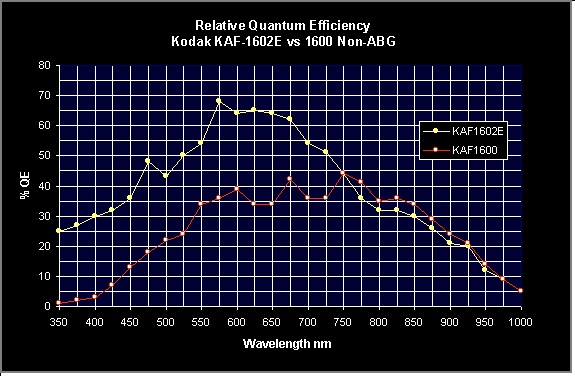 |
The chart above shows the QE results for sample KAF-1602E and KAF-1600 non-ABG detectors
tested under identical conditions. The new KAF-401E has the same enhanced response
as the KAF-1602E. The two samples clearly demonstrate the new "E" version
of the detector is much more sensitive than the standard detector from the UV to the
IR. The enhanced detector has good UV sensitivity even out past 350 nm!
Assuming that the standard ABG detectors are roughly 30 to 50 percent less sensitive than
the non-ABG detectors, then the enhanced non-ABG detectors are as much as four times as
sensitive as the standard ABG detector across the visible spectrum, and ten times as
sensitive at the far end of the blue spectrum. We have compared standard ABG cameras
to the new enhanced non-ABG camera at the telescope and the enhanced non-ABG camera yields
approximately 4 times the signal as a standard ABG detector under similar
conditions. The difference is quite
dramatic.
RELATIVE SPECTRAL RESPONSE THROUGH RED, GREEN & BLUE INTERFERENCE FILTERS |
||
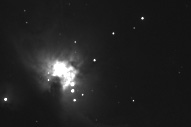 |
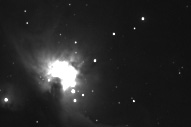 |
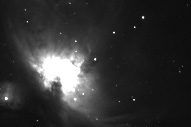 |
STANDARD ABG 30 SEC BLUE |
STANDARD ABG 30 SEC GREEN |
STANDARD ABG 30 SEC RED |
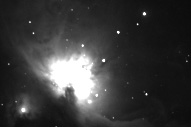 |
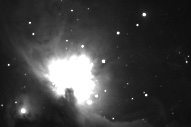 |
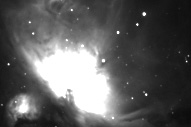 |
ENHANCED NABG 30 SEC BLUE |
ENHANCED NABG 30 SEC GREEN |
ENHANCED NABG 30 SEC RED |
 |
||
RGB + IR BLOCKING FILTER PASSBANDS (nm) |
||
THE IMAGES IN THIS TABLE WERE ALL TAKEN ON THE SAME
NIGHT THROUGH THE
SAME TELESCOPE |
||
RELATIVE FULL SPECTRUM RESPONSE (INCLUDING INFRARED) |
|
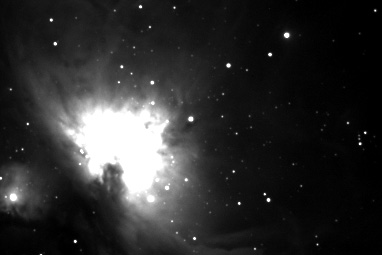 |
M42
and companion M43 Standard ST-8 ABG detector 30 second exposure No filter |
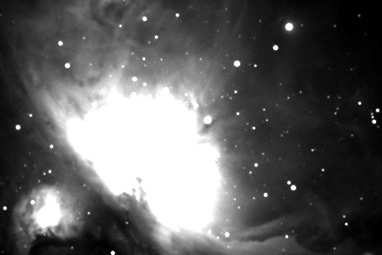 |
M42
and companion M43 Enhanced ST-8 NABG detector 30 second exposure No filter |
| Note:
These images are displayed without log scaling or other manipulation to reduce
the core brightness of the nebulas. The range settings are identical. The difference in nebulosity seen in M43 and in the outer areas of M42 is due entirely to the difference in the sensitivity of the detectors. |
|
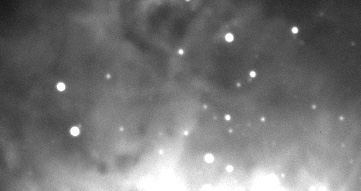 |
Enlarged portion of a region of H-alpha and O-III nebulosity in M42. 30 second exposure taken with an ST-8E through an 11" SCT at f/6.3 |
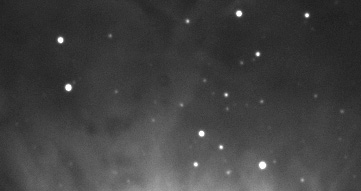 |
30 second exposure
of the same area of nebulosity in M42 taken with a standard ST-8 ABG through an 11" SCT at f/6.3 (note this image has slightly better focus) |
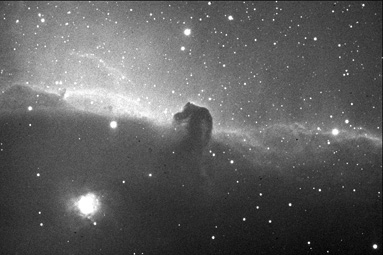 |
Horsehead
Nebula 2 x 5 minute ST-8E images taken through a 6" f/7 refractor with Red + IR blocking filter. Co-added with CCDOPS. Alan Holmes and Michael Barber / SBIG |
Revised: May 10, 2004 01:49:26 PM.
Copyright © 1998 Santa Barbara Instrument Group, Inc. All rights reserved.
Please report any problems with this page directly to the Webmaster